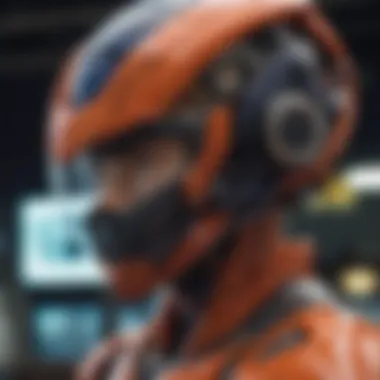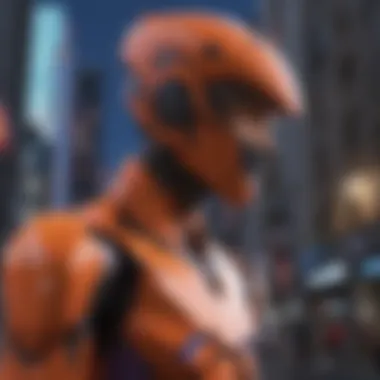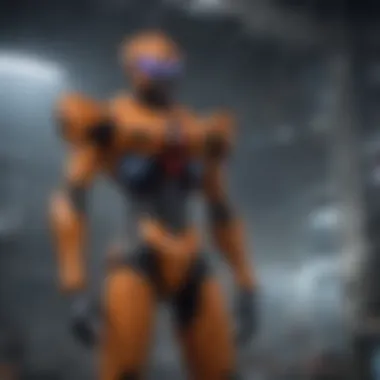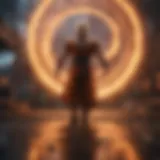The Rebuild of Evangelion: A Blu-ray Retrospective
Intro
The Rebuild of Evangelion has become an essential reference point in the landscape of anime. This series not only revisits an iconic franchise but also pushes technological boundaries in the realm of film presentation. The release of the Blu-ray format showcases the deep commitment to both quality and artistry. This article explores the multilayered aspects of the Rebuild of Evangelion Blu-ray series, shedding light on its production landscape, restoration efforts, and substantial impact within the anime industry.
Throughout this discussion, a detailed examination will unfold, addressing the technical enhancements the format brings, the cultural significance of the series, and how it has resonated with audiences and critics alike. In documenting various features and processes, this guide aims to assist both longtime fans and newcomers in appreciating this pivotal work.
Industry Insights
As anime continues to evolve, it is crucial to understand the industry's current state and emerging trends. The Rebuild of Evangelion holds relevance in broader discussions about the future and direction of anime. Today, the anime industry is witnessing key developments:
- Streaming Dominance: Streaming platforms have rapidly changed viewing habits. This makes series like Rebuild of Evangelion more accessible to global audiences.
- Quality over Quantity: Productions are focusing on fewer titles but with higher production values. The meticulous craftsmanship of Rebuild reflects this trend.
- Intersection with Other Mediums: Anime now interacts with video games and live-action adaptations more than ever. Understanding this can provide insight into evolving viewer preferences and artistic fusions.
Ultimately, the industry appears to embrace innovation while honoring legacy. The Rebuild of Evangelion seamlessly encapsulates this dynamic.
"The Rebuild of Evangelion series signifies crucial advances in both anime production and audience engagement across diverse platforms."
Reviews & Recommendations
Hailed as a groundbreaking adaptation, Rebuild has garnered extensive critical attention. Using a thorough examination of different aspects will clarify what makes it noteworthy.
- Film Ecosystem Review: Each film released in the Rebuild series contributes to a broader cinematic landscape, enhancing the original narrative and providing fresh interpretations.
- Cultural Reflections: The themes explored reflect broader societal issues attracting both seasoned fans and uptodate audiences.
- Must-Watch Recommendations: It is crucial to encourage insights into not just the Rebuild series but complementary works and showcases that resonate with similar themes, enhancing viewer experience.
News & Updates
Current beats throughout the anime community highlight ongoing discussions surrounding the Rebuild of Evangelion series. While the finality may offer closure, many conversations around the series continue. Notably:
- Fresh remasters or additional scene cuts that theorists speculate over influencing fan takes.
- New interpretations highlighted during recent anime conventions or streaming specials could shed light on previously unexplored narrative threads.
Keeping an ear to the ground regarding future announcements keeps fans not just engaged but enhances public discourse around the Rebuild's longevity.
Feature Articles
Understanding Rebuild more deeply reveals roots and ideologies behind not only characters but how they evolved in remarkably self-reflective narratives.
- Analytical Deep Dives: Dive into character arcs to explore motivations driving forces that form the backbone of proceedings within the series—focusing on how original narratives have expanded.
- Community Insights: Examining ongoing subculture themes observed around dedicated online communities can clarify how the series resonates across generational divides.
In essence, these assembled narratives ensure understandings formulated around Rebuild stand strong against the test of divergent and changing trends in available entertainment.
Introspection of the Rebuild of Evangelion: a guide for enlightenment.
Prelims to the Rebuild of Evangelion
The Rebuild of Evangelion is a vital discussion topic in understanding how this series reshapes anime as an art form. This section centers on setting the stage for the exploration that unfolds in the article. The franchise has a profound legacy, stemming from its original series, which resonates through decades. Picking apart why and how the Rebuild series reinvigorates the storyline gives deeper insights into both the narrative and its cultural significance.
Overview of the Evangelion Franchise
The Evangelion franchise began with Neon Genesis Evangelion, created by Hideaki Anno and released in 1995. It diverged from typical mecha tropes, introducing psychological depth alongside action sequences. Since its debut, Evangelion has continually influenced media and culture on a global scale. It delves into conflict, identity, and emotional struggles in a post-apocalyptic world. The complexity of characters, especially Shinji Ikari, has prompted numerous analyses and discussions.
Factors broadening the scope of its impact include
- merchandise that extends the universe
- movies that spawn from its narrative headlines,
- and collaborations across different media formats.


By creating rich characters influenced by various themes, Evangelion cemented its place in the annals of anime history, propelling it into a federation of millions of passionate fans worldwide.
Significance of the Rebuild Series
The Rebuild series premiered starting in 2007 with Evangelion: 1.0 You Are (Not) Alone and was pivotal for both the story and the franchise.
Firstly, offering a reimagined perspective on the original narrative allowed long-term fans to regroup their understanding and engage anew. Rebuilding the core narrative while fleshing out visuals served various functions. Evaluatively, one can note the quiet desire for a modern iteration that reflects changing societal contexts.
Moreover, the Rebuild series enables the introduction of advanced animation techniques, which enhances storytelling capacity. Minor characters come forth with more substantial arcs, affecting emotional resonance.
Highlighting this unique endeavor, the Rebuild series is considered not just a rehashing but becomes a layered commentary on the original piece, broadening and expanding its relevance. It encourages discussion related to the original, opening avenues for deeper philosophical interpretations.
The Rebuild films, while retelling familiar tales, walk a tightrope between nostalgia and innovation.
In a sense, the Rebuild series encapsulates more than just plotlines; it embodies art that sparks striving conversations in pop culture speculation and theoretical dissection. Key themes enlarging the conversation involve trauma, choice versus destiny, and existential crises, indicating the depth of material treated by Anno and his team.
Understanding Blu-ray Technology
The emergence of Blu-ray technology marked a turning point in home entertainment. It offers significant advantages over traditional DVD formats. Understanding these enhancements is vital for appreciating the Rebuild of Evangelion series on Blu-ray. The information in this section highlights the technical traits that elevate viewing experiences, ultimately supporting the overall value of the series.
Advantages of Blu-ray Over
Blu-ray discs, commonly abbreviated as BD, provide numerous benefits compared to DVD. Here are some key points of comparison:
- Higher Storage Capacity: Blu-ray offers much more space for data—up to 25GB for single-layer and 50GB for dual-layer discs, compared to DVDs, which typically hold around 4.7GB.
- Superior Video and Audio Quality: The advanced codecs used in Blu-ray enable impressive quality with 1080p resolution for video and lossless audio formats like DTS-HD Master Audio and Dolby TrueHD.
- Enhanced Features: Blu-ray allows for interactive features and content sharing, enhancing the viewer experience with immersive extras that a standard DVD simply can't offer.
- Progressive Scanning: Blu-ray discs are designed for progressive scanning, which subsequently improves video quality and minimizes artifacts.
Resolution and Picture Quality Improvements
One of the most flagged improvements in the shift from DVD to Blu-ray is the resolution and picture quality. Here are some details:
- Full HD Resolution: Blu-ray's capacity to present content in full 1080p resolution brings sharper images. It creates more defined lines, deeper colors, and less blurriness compared to DVDs.
- Color Depth: Blu-ray boasts a greater color depth, supporting millions of colors through advanced encoding techniques. This comes into play significantly during intricate animated sequences like those present in the Rebuild of Evangelion.
- Blu-ray Advanced Technology: Features such as dual-layer capability ensure that more visual data is stored without sacrificing quality. Again, this serves the complex animation styles present in the Eva series, allowing for crystal clear visuals.
Considering these elements of Blu-ray technology strengthens the appreciation of the Rebuild of Evangelion series and its presentation. The advanced technology offers viewers not only a cinematic experience but one that amplifies the original artistic intentions behind the series.
Production Journey of the Rebuild Films
The production journey of the Rebuild of Evangelion films is not just an account of making movies. It is a complex saga that illustrates the visionary drive and meticulous artistry behind one of anime's most iconic franchises. The Rebuild series was initiated as a way to retell and reimagine the original Neon Genesis Evangelion series, released in the 1990s. With advancements in technology and shifts in audience expectations, this endeavor was both a revival and a reestablishment of relationships with fans and critics alike.
Understanding this production journey shines a light on not only the works themselves but also the innovative process that created them. Through various technological improvements and shifts in storytelling approaches, the Rebuild series redefined its narrative ADN presented old characters in strikingly new contexts. This exploration will cover key personnel, the timeline of development, and the animation techniques that contributed to this artistic triumph.
Key Personnel Involved
The Rebuild of Evangelion highly relied on its core creators, who shaped the visual and emotional landscape of the series.
- Hideaki Anno: As the director and the mastermind behind Evangelion, Anno's creative vision was paramount in bringing this project to life. His commitment to artistic integrity and deep exploration of human psychology is a recurring theme in all four films.
- Khara Studio: Founded by Anno himself, this studio played a major role in the production. The dedication of the team at Khara provided the creative environment necessary for the reinvigoration of the Evangelion narrative.
- Gross revenue: The backgrounds, mechanical designs, and character designs saw immense refinement due to collaboration between artists. Newer attribution techniques drew in talents that helped elevate illustrated works jaw-droppingly.
The choice of creative leads emphasizes how the personal involvement of key figures makes for richer storytelling and remarkable visuals. The collaborative spirit between people involved in these films was essential in achieving coherence and an engaging audience experience.
Development Timeline and Milestones
The journey from initial concept to final release illustrates the dedication and strategic planning involved in the Rebuild series. Key moments include:


- 2006: The first film, Evangelion: 1.0 You Are (Not) Alone, was released, presenting familiar elements with a fresh perspective. Its early success revitalized interest in the franchise.
- 2007: The realization that a four-part strategy was crucial for concluding character arcs and themes led to solidifying the roadmap for further installments.
- 2009-2012: The subsequent films were released: Evangelion: 2.0 You Can (Not) Advance, Evangelion: 3.0 You Can (Not) Redo, and Evangelion: 3.0+1.0 Thrice Upon a Time. Each release raised the bar for animation complexity and thematic depth, often expanding the scope of discussions around the narrative!
Tracking these milestones highlights how practical and artistic evolution dictated the development of each film. Each release marked not just the unveiling of new visual arts, but an ongoing exploration of storytelling that became increasingly ambitious.
Animation Techniques Employed
The animation techniques employed in the Rebuild of Evangelion represent a fascinaing blend of tradition and innovation. The transition from the original series to the Rebuild involved several significant updates:
- CGI Integration: Traditional hand-drawn animation was enhanced with computer-generated imagery. This provided more fluid motion and scale, critical for the large-scale battles and psychological depth interactions between characters.
- High-Definition Formats: Moving from standard definition to high definition allowed for sharper visuals and heightened emotional impact. Viewers can better appreciate subtleties in character design and environments, enriching the experience.
- Innovative Lighting and Texturing: New techniques in lighting create mood and emphasize themes within scenes. Texture improvements provide depth that reflects psychological states or world-building in distinct ways.
In summary, the reimagination of Evangelion's artistic foundation is as vital as its narrative depth. Each step of production contributed significantly to both series evolution and overarching themes depicted throughout the films. The investigation of production enfolds complex dynamics of artistry, technique, and innovative expressions within a beloved franchise.
Enhancements and Features of the Blu-ray Release
The Rebuild of Evangelion series transitioned to Blu-ray offers significant advancements that redefine the viewing experience. Understanding these enhancements is vital for both existing fans and new viewers, as they significantly impact how the series is perceived and appreciated.
Visual and Audio Upgrades
The visual quality in the Blu-ray release stands apart from earlier formats. The increased resolution, now up to 1080p, allows details not visible in DVD versions to emerge clearly. This sharpness can be seen throughout the intricate animation, particularly during action sequences and detailed environment designs. Improved colors showcase the artistic intent, transforming the visual ambience to a more immersive state, akin to what the creators might have envisioned.
In addition to visual upgrades, the audio aspects are noteworthy. The Blu-ray formats support lossless audio, enveloping viewers in soundscapes that remain true to the original recordings. The clarity and depth of surround sound position viewers right within the action, enhancing their engagement with the narrative.
Special Features and Extras
Blu-ray releases often come endowed with a suite of special features, and the Rebuild of Evangelion is no exception. These extras can include commentaries from directors and staff members, production sketches, and behind-the-scenes footage.
Such features provide invaluable insights into the creative process behind the series. Fans will uncover details that inform their understanding of not just the visuals, but also the themes embraced by the stories. Additionally, interviews with key creators should not be overlooked. They can reveal the philosophies underpinning the narrative choices made during development, enriching the viewer's perspective.
While some may view these extras modestly, their contribution to the overall experience is significant, enhancing appreciation of the work's complexity and its place within the broader anime landscape.
Comparative Analysis with Previous Formats
A crucial discussion revolves around contrasting the Blu-ray with its predecessors, like DVD and streaming formats. While DVDs served their purpose in the earlier days of home viewing, they are largely unable to support the rich details and high fidelity provided by Blu-ray.
First, resolution and bitrate play a key role. Unlike DVDs, which typically output a standard-definition picture, Blu-ray emerges with high-definition clarity, making images vivid and rich. Consequently, scenes that rely on visual storytelling gain more impact.
Another notable element is additional features unique to Blu-ray. Many earlier releases did not provide in-depth look into production elements. This left fans largely dependent on scant information available online or through scattered publications. The enhanced material in Blu-ray sets offers a consolidated space where both visual and contextual arcs connect organically.
Not only do these improvements elevate the sensory experience, but they also accommodate deeper analysis. Fans and scholars of anime can explore both storytelling and artistic innovations embedded within the Rebuild series through these formats.
Cultural Relevance of the Rebuild of Evangelion
The Rebuild of Evangelion stands out as an essential marker in the landscape of anime. Its cultural relevance extends beyond the series itself, touching on social, philosophical, and artistic concerns. This section addresses how Rebuild impacts anime as a medium and delves into the deeper themes underpinning its narrative.
Impact on Anime as a Medium
The Rebuild of Evangelion series has heightened the dialogue surrounding anime both . professional aspects creation and audience theories. Unlike its predecessor, the original Neon Genesis Evangelion, which aired in the 1990s, Rebuild reflects advancements in technology and storytelling approaches. It integrates modern themes, characters, and improved production techniques.
The reception of Rebuild indicates that anime is transiting towards '''heavily serialized’’' formats that are precise and wise. Attributes children audiences have come to expect high-caliber visuals along transformation in narrative arcs. Notably, the series appeals to different viewer demographics—from nostalgic fans to newcomers seeking recognition with anime.
Key influences include:


- Improved Production Quality: Enhanced animation techniques, including 3D modeling and CGI.
- Viewer Accessibility: The availability of Blu-ray editions and streaming services place anime into a global viewable context.
- Thematic Exploration: Tackling complex issues like psychological trauma and the incongruities of human experience gave room for thought discussions among fans and critics.
Themes and Philosophical Underpinnings
Many view Evangelion as more than mere entertainment; however, themes such as despair, alienation, and consciousness are intricately woven throughout. Rebuild takes* existential questions faced by its characters and forces the audience to reflect on their significance.
One notable theme is ‘Identity Crisis’: it addresses the characters’ struggles find their worth in line with soul experiments against existential contents and societal demands. in particular, grows through metaphorical encounters within the narrative. This pivotal exploration has warranted much analysis within academic discussions.
Moreover, philosophies of Friedrich Nietzsche and ideas surrounding postmodernism often serve as lenses through which to view the Rebuild of Evangelion. Deconstruction of vilifiable relationships and the examination of *tim неопmaованиемоеие ма хә-identity propounds reasoning and resonates deeply with global audiences.
In summary, the cultural weight of Rebuild reflects broader themes that transcend Eastern and Western boundaries. These narratives challenge societal conventions and prompt criticism not easily pushed aside by spectators. This expansion into discussions regarding ideological paradigms offers fertile ground for understanding uninhabited creativity occurring within anime as a genre.
Audience Reception and Critique
Understanding the audience's reception and critique of the Rebuild of Evangelion is crucial to comprehending its place in pop culture. Evengelion has transcended mere entertainment, becoming a significant player in discussions surrounding anime. The feedback from both critics and fans can greatly influence perceptions, especially when it comes to the legacy and future of the franchise.
Engaging with audience reactions allows for a deeper analysis of how the films were received upon release and in subsequent years. It sheds light on varying interpretations, emphasizing personal, cultural, and social contexts. Such insights can assist new viewers in grasping the essential elements that have made Evangelion so impactful.
Critical Acclaim and Controversy
The Rebuild of Evangelion films became a focal point for filmmakers, critics, and audiences alike. Critics have often praised the series for its ambitious storytelling and visual style, pushing the boundaries established by the original series. However, this same boldness sparked controversy, resulting in polarized opinions in some notable areas.
Many find the production quality unmatched. The animation, music, and direction received acclaim for their fluid execution. The updated visual artistry elevates moments that resonate deeply with fans. Conversely, criticisms often stem from accusations that the plots diverged too drastically from the emotional core of the original narrative. This creates buzzing debates within the community regarding fidelity and creative evolution.
‘The Rebuild films serve as both a celebration and re-imagining. Not all approaches are warmly welcomed. Discussions become heated but enriching.’
Fan Reactions and Community Engagement
Community feedback plays a crucial role in nurturing the discourse surrounding the series. Fans not only critique the films but also engage in extensive discussions on various platforms. Through forums, social media, and fan conventions, the community demonstrates a vibrant engagement with both the films and their underlying themes.
Community engagement manifests in different ways:
- Forums and Subreddits: Platforms like Reddit have become hubs for analyses, theories, and speculations. Here, fans dissect each frame, exploring implications of character choices and plot twists.
- Visuals: Fan art, cosplays, and video edits frequently populate social medi channels, further enhancing community connections.
- Thematic Analysis: Fans write essays that delve into the philosophical questions raised by the films, sparking stimulating debates.
Fans experience a sense of connection with other viewers who share similar passions. This engagement enhances the legacy of the series, creating a cycle of appreciation and critique. Together, these reactions shape not only how the Rebuild of Evangelion is perceived today but how its legacy will continue to live on. Overall, understanding audience reception is essential not only for marketing efforts but for acknowledging the content's influence on animation and broader media.
Culmination: The Legacy of the Rebuild of Evangelion
The Rebuild of Evangelion series serves as a vital chapter within both the history of the franchise and the broader anime landscape. As we appreciate its production and distribution on Blu-ray, it is crucial to reflect on the various dimensions of its legacy. This legacy consists not only in the delivery of high-quality audiovisual experiences but also in how it influences other creators and genres.
Future of the Franchise
The future of the Evangelion franchise remains shrouded in speculation yet teems with potential. Following the emotionally charged conclusion of the Rebuild series, discussions about new narratives or spin-offs have surfaced among fans and critics alike. There are possibilities for innovative film adaptations or television series that build on Rei, Shinji, Asuka, and Gendo's stories, allowing new explorations of the existing character arcs. Business moves could influence direction. Licensing deals, studios' interests, or further resurrections from Hideaki Anno could reshuffle the deck.
Fans also anticipate collaborations. Evangelion themes have permeated video games and merchandise. Existing properties benefit from Evanlegion's distinctive motifs, enhancing both fan connections and new marketplace strategies. Future franchises may take cues from the tonal complexities that Rebuild introduced, altering how anime engages with audiences.
In summary, as the fan base grows and diversifies, the potential routes for the franchise traverse various media forms, ensuring the essence of Evangelion finds ongoing relevance further in the anime ecosystem.
Enduring Influence on Pop Culture
The enduring influence of the Rebuild of Evangelion on pop culture is palpable. This series impacted cinematic narratives, storytelling norms, and visual aesthetics far beyond anime. The emotional depth and complex characters have inspired a diverse array of multimedia contents.
Essential aspects of the influence are:
- Thematic Exploration: The way the series delves deep into trauma, identity, and consciousness resonates across many artworks. This approach compels creators in multiple leisure sectors to consider similar depths in their narratives.
- Visual Style: Richly detailed visuals and imaginative art directions pioneered by Gainax and Khara continue to set standards for visual storytelling.
- Concepts and Juventus: The show's transcendence of mere genre constraints has seeded exploration within mainstream media frameworks.
Moreover, transcription from original concepts have initiated critical dialogue about storytelling and futurism. The Rebuild films challenge disconnection among realities which influence current discussions, marketing campaigns, and creator interviews alike. The network created is not just for poets, it's for theorists and enthusiasts in pop cultural dialogues.
"Evangelion forces contorted speculations of post-modern universes into dysfunctional, yet therapeutic dialogues. This duality lies at its supreme influence." - a sentiment echoed among integrated audiences of varied genres.



